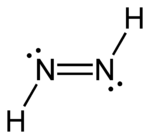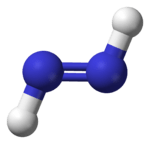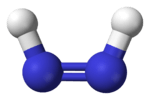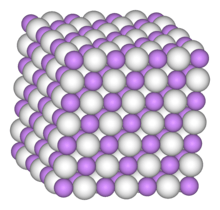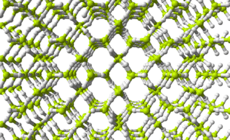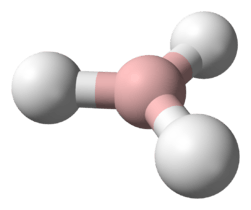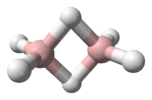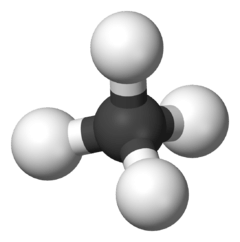Diimide
Diimide, also called diazene or diimine, is a compound having the formula (NH)2. It exists as two geometric isomers, E (trans) and Z (cis). The term diazene is more common for organic derivatives of diimide. Thus, azobenzene is an example of an organic diazene.
| |||
| |||
| Names | |||
|---|---|---|---|
| IUPAC name
Diazene | |||
| Other names
Diimide Diimine | |||
| Identifiers | |||
| |||
3D model (JSmol) |
|||
| ChEBI | |||
| ChemSpider | |||
| KEGG | |||
| MeSH | Diazene | ||
PubChem CID |
|||
| UNII | |||
CompTox Dashboard (EPA) |
|||
| |||
| |||
| Properties | |||
| H2N2 | |||
| Molar mass | 30.030 g·mol−1 | ||
| Appearance | Yellow gas | ||
| Melting point | −80 °C (−112 °F; 193 K) | ||
| Related compounds | |||
Other anions |
diphosphene dinitrogen difluoride | ||
Other cations |
azo compounds | ||
Related Binary azanes |
ammonia diazane triazane | ||
Related compounds |
isodiazene triazene tetrazene | ||
Except where otherwise noted, data are given for materials in their standard state (at 25 °C [77 °F], 100 kPa). | |||
| Infobox references | |||
Synthesis
The traditional route to diimide involves oxidation of hydrazine with hydrogen peroxide or air.[1] Alternatively the decarboxylation of azodicarboxylic acid affords diimide:[2]
- (NCOOH)2 → (NH)2 + 2 CO2
Diimide can also be efficiently generated by elimination of sulfonohydrazides using a suitable base. For example, 2,4,6-triisopropylbenzenesulfonohydrazide eliminates diimide upon treatment with sodium bicarbonate.
Because of its instability, diimide is generated and used in-situ. A mixture of both the cis (Z-) and trans (E-) isomers is produced. Both isomers are unstable, and they undergo a slow interconversion. The trans isomer is more stable, but the cis isomer is the one that reacts with unsaturated substrates, therefore the equilibrium between them shifts towards the cis isomer due to Le Chatelier's principle. Some procedures call for the addition of carboxylic acids, which catalyse the cis–trans isomerization.[3] Diimide decomposes readily. Even at low temperatures, the more stable trans isomer rapidly undergoes various disproportionation reactions, primarily forming hydrazine and nitrogen gas:[4]
- 2 HN=NH → H2N–NH2 + N2
Because of this competing decomposition reaction, reductions with diimide typically require a large excess of the precursor reagent.
Applications to organic synthesis
Diimide is occasionally useful as a reagent in organic synthesis.[3] It hydrogenates alkenes and alkynes with selective delivery of hydrogen from one face of the substrate resulting in the same stereoselectivty as metal-catalysed syn addition of H2. The only coproduct released is nitrogen gas. Although the method is cumbersome, the use of diimide avoids the need for high pressures or hydrogen gas and metal catalysts, which can be expensive.[5] The hydrogenation mechanism involves a six-membered C2H2N2 transition state:
Selectivity
Diimide is advantageous because it selectively reduces alkenes and alkynes and is unreactive toward many functional groups that would interfere with normal catalytic hydrogenation. Thus, peroxides, alkyl halides, and thiols are tolerated by diimide, but these same groups would typically be degraded by metal catalysts. The reagent preferentially reduces alkynes and unhindered or strained alkenes[1] to the corresponding alkenes and alkanes.[3]
Related
The dicationic form, HNNH2+ (diprotonated dinitrogen), is calculated to have the strongest known chemical bond. This ion can be thought of as a doubly protonated nitrogen molecule. The relative bond strength order (RBSO) is 3.38.[6] FNNH2+ and FNNF2+ have slightly lower strength bonds.[6]
References
- Ohno, M.; Okamoto, M. (1973). "cis-Cyclododecene". Organic Syntheses.; Collective Volume, 5, p. 281
- Wiberg, E.; Holleman, A. F. (2001). "1.2.7: Diimine, N2H2". Inorganic Chemistry. Elsevier. p. 628. ISBN 9780123526519.
- Pasto, D. J. (2001). "Diimide". Encyclopedia of Reagents for Organic Synthesis. John Wiley & Sons. doi:10.1002/047084289X.rd235.
- Wiberg, Nils; Holleman, A. F.; Wiberg, Egon, eds. (2001). "1.2.7 Diimine N2H2 [1.13.17]". Inorganic Chemistry. Academic Press. pp. 628–632. ISBN 978-0123526519.
- Miller, C. E. (1965). "Hydrogenation with Diimide". Journal of Chemical Education. 42 (5): 254–259. doi:10.1021/ed042p254.
- Kalescky, Robert; Kraka, Elfi; Cremer, Dieter (12 September 2013). "Identification of the Strongest Bonds in Chemistry". The Journal of Physical Chemistry A. 117 (36): 8981–8995. doi:10.1021/jp406200w. PMID 23927609.
